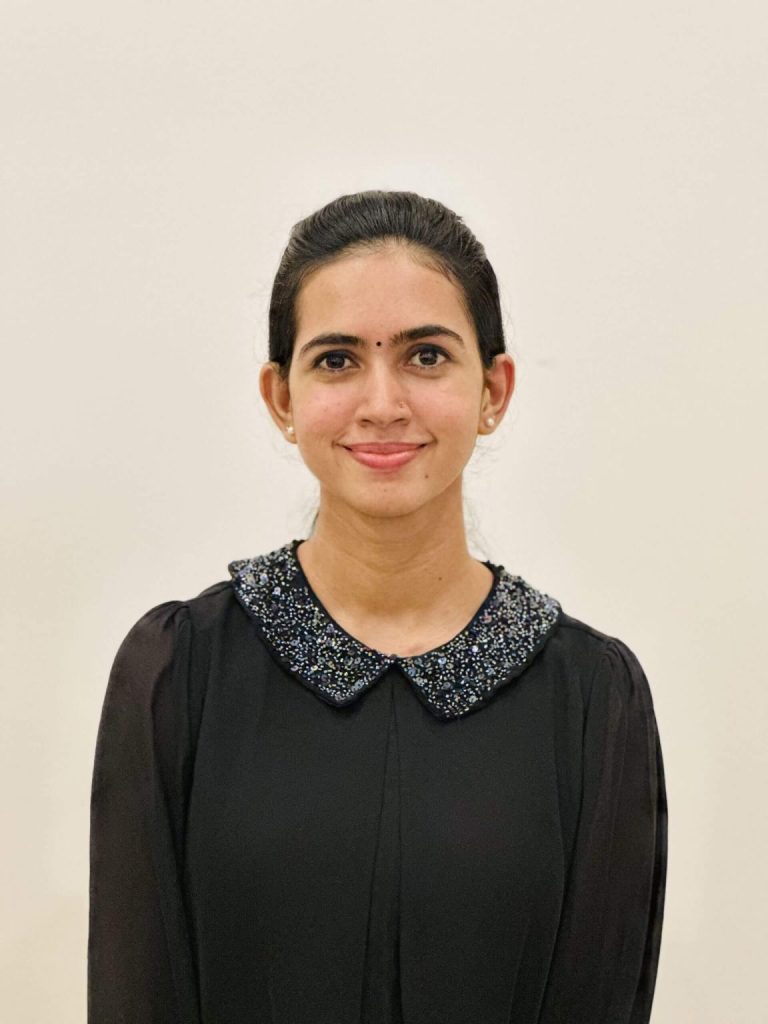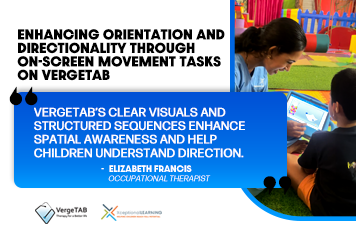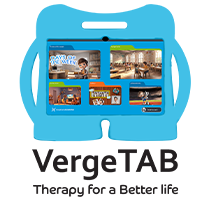Enhancing Orientation and Directionality Through On-Screen Movement Tasks on VergeTAB
08 Aug 2025

In today’s digital world, therapy tools must go beyond entertainment—they should teach, support, and empower. Spatial skills like orientation and directionality are crucial for children with developmental delays. VergeTAB, a distraction-free therapy tablet powered by the XceptionalLEARNING platform, offers focused, goal-based learning through interactive on-screen movement tasks. Unlike generic apps, VergeTAB delivers structured activities designed to build these essential skills in a practical, measurable way.
Understanding Orientation and Directionality: Beyond Definitions
Orientation is a child’s ability to know their position in space and recognize relationships with objects and people. Directionality involves understanding movement about the self and others — up/down, left/right, forward/backward.
These skills influence:
- Letter recognition and proper formation
- Reading direction (left to right)
- Map navigation and route following
- Body coordination and physical movement
- Daily functions like dressing or setting a table
For neurodivergent children, these aren’t always simple. They require repetition, sensory input, and clear visual guidance — all built into the XL platform and delivered via VergeTAB.
Why VergeTAB Is Different
Unlike regular tablets, VergeTAB is a blank, locked device activated only through the XL platform. It ensures:
- No distractions or app switching
- Therapist-controlled, secure sessions
- Focused, goal-based learning
VergeTAB works solely with structured therapy modules, making it ideal for building orientation and directionality skills.
Practical On-Screen Movement Tasks on VergeTAB
Let’s explore practical solutions — not just theory — for building these crucial spatial skills through VergeTAB.
1. Directional Tracing Paths
- Activity Name: Find Your Way
- Therapy Type: Occupational Therapy
- Target Skill: Tracking movements from left to right, top to bottom, and along diagonal paths
The XL platform presents a maze or a winding path. Children must trace it by dragging their finger, following verbal cues like:
- “Start at the top left corner.”
- “Move down and to the right.”
- “Find the circle and drag to the square.”
Why It Works:
- Reinforces spatial direction using finger movement
- Strengthens eye-hand coordination
- Mirrors reading flow (left-to-right, top-to-bottom)
Focus: This activity builds visual-motor integration and fine motor control, which are core goals in occupational therapy. Tracing paths reinforces hand-eye coordination, left-to-right motion (important for writing), and directionality awareness.
2. Left vs. Right Identification Games
- Activity Name: Which Way?
- Therapy Type: Special Education / Occupational Therapy
- Target Skill: Body awareness and left–right orientation
Children see two animated hands or shoes. They hear prompts like:
- “Tap the left shoe.”
- “Move the right hand up.”
- “Turn the arrow to your left.”
Why It Works:
- Visual reinforcement links left/right with real body parts
- Immediate feedback builds body schema awareness
Focus:
- In Special Education, it’s used to support reading directionality and conceptual understanding of spatial terms.
- In Occupational Therapy, it enhances body awareness, spatial orientation, and motor planning—knowing left/right on the body is crucial for daily tasks.
3. On-Screen Movement Commands
- Activity Name: Command and Move
- Therapy Type: Speech Therapy / Occupational Therapy
- Target Skill: Auditory processing and understanding directionality
The XL module says: “Swipe up,” “Tap the object to the right,” or “Move the ball down and left.” The child responds by physically manipulating on-screen objects accordingly.
Why It Works:
- Strengthens processing of verbal direction
- Combines listening with motor planning
- Builds cross-body coordination
Focus:
- In Speech Therapy, following directional commands (“move the ball left”) improves receptive language and auditory processing.
- In Occupational Therapy, it supports motor planning and sequencing movements based on spatial terms.
Therapist Input: You can increase complexity by adding dual-step commands: “Swipe left, then tap the star.”
4. Obstacle Course Simulations
- Activity Name: Virtual Track
- Therapy Type: Occupational Therapy / Behavioral Therapy
- Target Skill: Sequencing directional steps accurately
Children guide a character through a mini obstacle course using a sequence of movement commands, such as:
“Move up → Jump right → Slide down → Turn left.”
Why It Works:
- Introduces sequencing of directions
- Mimics physical movement using fine motor skills
- Teaches children how to interpret compound instructions
Focus:
- In Occupational Therapy, these tasks work on gross motor planning, spatial navigation, and body coordination.
- In Behavioral Therapy, they can be used to build attention, task persistence, and following multi-step instructions in a structured format.
Progress Tracking: The XL platform logs time taken, errors made, and repetitions needed.
5. Grid Navigation Tasks
- Activity Name: Map It Out
- Therapy Type: Special Education / Occupational Therapy
- Target Skill: Spatial planning and orientation skills
Children see a 3×3 or 5×5 grid with labeled boxes. The instruction: “Move from the red square to the yellow one using only right and down movements.”
Why It Works:
- Teaches directional thinking in constrained space
- Enhances logical movement planning
- Imitates classroom concepts like graphs or maps
Focus:
- In Special Education, grids help with mathematical reasoning, sequencing, and visual-spatial problem-solving.
- In Occupational Therapy, it targets planning movements, scanning visual fields, and spatial accuracy.
Bonus Feature: Teachers can tie this to real-world skills like reading maps or arranging objects in space.
Why This Matters in Real Life
Now that we’ve seen practical examples, let’s break down how they help in everyday situations:
| Skill Gained | Real-Life Application |
|---|---|
| Knowing left from right | Putting on the right shoes, listening to teacher’s instructions |
| Understanding directions | Reading books in the right order, lining up schoolwork neatly |
| Doing steps in order | Finding their way in school, tidying up toys, packing their bags |
| Following spoken directions | Playing games in PE, following songs, doing classroom activities |
| Planning how to move | Riding a bike, safely crossing roads, joining sports and playground fun |
These are not optional skills — they are foundational to independence.
Research-Backed Approach
Numerous studies support the use of screen-based, interactive tools in occupational therapy and special education:
- Children retain more when learning is multisensory (visual + touch + auditory).
- Visual tracking tasks improve reading fluency.
- Consistent left-right training correlates with better handwriting outcomes.
VergeTAB, with XL’s tailored content, is built directly on this research, turning scientific insights into practical interventions.
Therapist and Parent Control
- Therapists and educators using the XL platform can:
- Assign tailored directionality tasks to each child
- Monitor real-time progress
- Adjust difficulty levels based on the child’s pace
- Add voice prompts and feedback
Parents can use the same tasks at home to support therapy between sessions, maintaining consistency and reducing regression.
Results That Matter
Children using VergeTAB through the XL platform have shown measurable improvements in:
- Spatial reasoning and body awareness
- Following classroom directions
- Reading comprehension (tracking left to right)
- Improved handwriting through better letter orientation
Most importantly, these improvements carry over into everyday life—helping children better understand where they are in the world and how to move through it.
Want to explore how VergeTAB enhances therapy sessions?
Focus Areas / Skills Developed:
- Technology integration in special education
- Therapist dashboards for personalized planning
- Data-driven progress tracking and IEP support
- Visual routines and structured learning paths
This video highlights VergeTAB’s practical use in therapy and special education, reinforcing both academic and developmental skills in an engaging digital format.
In conclusion, orientation and directionality aren’t just academic skills but life skills. Without them, children struggle to read, write, move safely, and participate fully. Traditional worksheets and verbal prompts can only go so far. VergeTAB, activated via the XL platform, brings these skills to life. Through clear on-screen movement tasks, children learn to track, navigate, follow, and plan — all in a safe, therapist-guided environment. It’s structured. It’s practical. It’s measurable. If you’re a parent, teacher, or therapist looking for a reliable way to help your child or student master directionality, VergeTAB provides a modern, effective, and research-connected solution. It serves as a Digital Therapy Activity Device, helping children engage with structured movement tasks that build essential spatial skills. As an Interactive Learning Device for Children, it supports hands-on activities designed to improve focus and understanding through visual and tactile learning. Contact us at +91 8921287775 today to discover the power of movement-based learning with VergeTAB and the XL platform.


